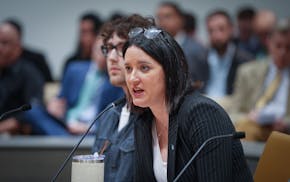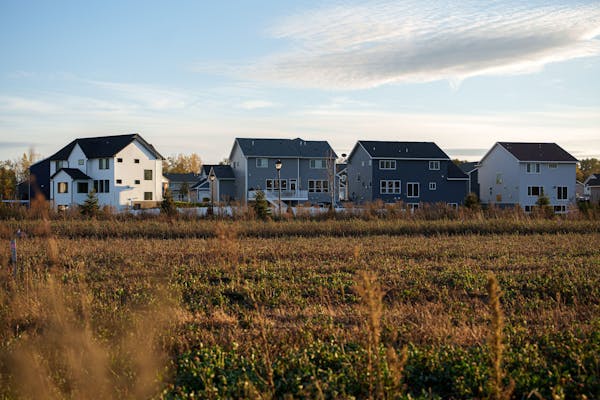Brooklyn Center city officials and residents say the Minnesota Department of Transportation isn't taking their concerns into account as plans proceed to convert Hwy. 252 from an expressway with traffic signals into a freeway with exit ramps.
MnDOT officials say that making a freeway out of Hwy. 252, which connects the north metro to Minneapolis via Interstate 94, will reduce crashes by eliminating intersections where rear-end collisions often occur as drivers transition from I-94.
But opponents say MnDOT's proposed designs don't reflect their desires and will only add traffic and pollution to the corridor, which is considered a state environmental justice community based on income and diversity metrics.
Brooklyn Center Mayor April Graves told MnDOT officials at an Oct. 25 meeting that the proposed designs don't reflect state goals for improving equity, and added that the vast majority of public comments on the designs were negative. "It doesn't feel like you've listened," she said.
Mark Lindeberg, MnDOT's West Area manager, said the department went through more than 500 comments submitted and responded to all of them. The biggest priorities for the project are vehicle mobility, improving walking and biking conditions, and vehicle safety, according to the purpose and needs document.
Ultimately, Lindeberg said, those priorities played the biggest role in sticking with four design options moving forward. "Were there major changes? No, there were not," he said.
The four design options being considered are:
A four-lane freeway with bus-only shoulders;
A six-lane freeway with a lane each for carpoolers and E-ZPass subscribers;
A six-lane freeway with bus-only shoulders;
A no-build option that largely leaves intact the current roadway, which has four to six lanes in different stretches and street-level stoplight intersections.
The project is entering the environmental review phase for the four options, during which state officials will analyze issues like air pollution impacts. That phase is expected to finish in 2026, and construction is tentatively scheduled for 2028.
The project area along I-94 and Hwy. 252 in north Minneapolis, Brooklyn Center and Brooklyn Park is among the most diverse in Minnesota. Most of the surrounding neighborhoods are home to more than 40% people of color, and more than 35% of the households are low-income.
MnDOT officials acknowledge that converting Hwy. 252 into a freeway will increase traffic, but they say early analysis indicates the project would increase vehicle miles traveled in the metro region by less than 1% in the next 20 years. MnDOT has a goal of reducing vehicle miles traveled by 20% by 2050.
Making Hwy. 252 a freeway would improve safety by separating transportation modes and increasing vehicle mobility on the roadway, while reducing traffic on local streets, officials say.
"Often our goal on projects is to provide options that include alternatives to driving, such as providing shoulders for buses and managed lanes, or E-ZPass lanes. The Hwy 252/I-94 project is advancing alternatives with both features as possible solutions," MnDOT spokesperson Ricardo Lopez wrote in an email.
Longtime Brooklyn Center resident Nahid Khan, who belongs to the Highway 252 Safety Task Force that opposes the freeway, said the process feels like a sham. Khan participated in a MnDOT community advisory committee that released a report in May saying that residents in the project area are 20% to 25% more likely to experience asthma or other chronic health issues than in other parts of Hennepin County.
The equity and health assessment also found that 14% of households in the project area don't own cars. "All we wanted was safety improvements. Nobody wanted a freeway," Khan said.
Khan and others say a freeway also would displace homes and businesses. Brooklyn Center City Council Member Dan Jerzak said a freeway could affect 40 businesses, many of which are owned by people of color. He fears a loss of tax revenue and business customers along the corridor once a freeway makes it easier to bypass the city.
MnDOT will need municipal consent from Brooklyn Center, Brooklyn Park, and Minneapolis to move forward with the project. The Minneapolis City Council has already passed a resolution opposing designs that expand vehicle lanes on the I-94 segment of the corridor.
While nothing has been officially decided, many in Brooklyn Center see the freeway design options as a significant step toward the project's outcome.
Graves and others at the Oct. 25 meeting said they want MnDOT to consider non-freeway options that would slow traffic and improve safety on the roadway.
"To me, it seems that the alternatives that are being studied are so similar that there's not going to be much difference in what you find out from the environmental impact statement," Graves said.
MnDOT Deputy Commissioner Kim Collins said she agreed that the process doesn't feel intuitive and easy to explain. She said the department will look into potential changes to make it more accessible to residents.
"That's something I think we will continue to have to work on," Collins said.
About the partnership
This story comes to you from Sahan Journal, a nonprofit newsroom dedicated to covering Minnesota's immigrants and communities of color. Sign up for a free newsletter to receive Sahan's stories in your inbox.

Under pressure from advocates, Minnesota legislators debate proposal to allow early marijuana growing
Worker crushed, killed by concrete mixer in southeast Minnesota
Minnesota Education Department official testifies in Feeding Our Future trial about fraud concerns

Hennepin board OKs Moriarty's request to hire outside lawyers for Trooper Londregan prosecution
![Metropolitan Council Chair Charlie Zelle says the council "will take steps to ensure [rider] concerns are fully documented," following the release of](https://arc.stimg.co/startribunemedia/3DUUWUL3DKZ5KVG746POLRVCCM.jpg?h=91&w=145&fit=crop&bg=999&crop=faces)
